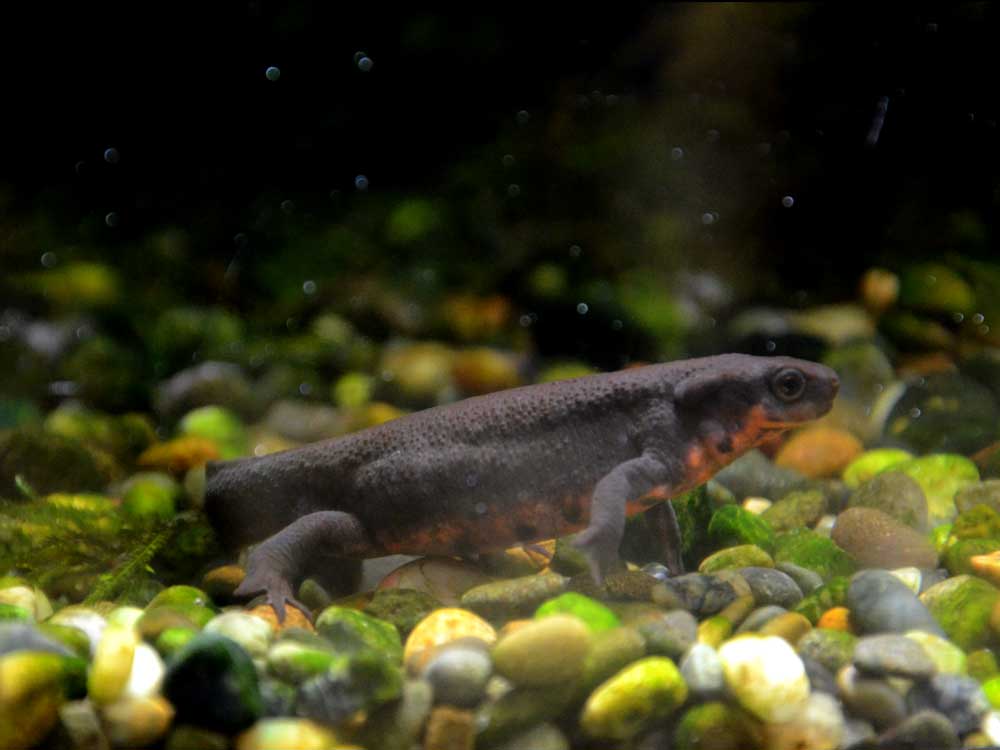
Cynops pyrrhogaster (Boie, 1826)
奇妙な媚薬のつくりかた
How to Make a Strange Aphrodisiac?
全長はオス 70 – 110mm、メス 80 – 140mmとメスの方が大きくなります。日本固有種の両生類であり、本州・四国・九州の水田、池、小川などに生息します。日本でイモリと言えば一般的にアカハライモリのことを指します。
長い尻尾を持ち、前肢は4本の指、後肢は5本の指があり、背中は暗褐色で腹部が赤く黒い班があることが特徴です。「テトロドトキシン」というフグが持っている毒と同じ種類の毒を持ち、赤い腹は毒を持っていることを主張する警告色です。
イモリの持つ能力で凄いのは身体の再生能力です。尾や足だけならトカゲも再生しますが、イモリは目の水晶体や、何と心臓まで再生させることができるのです。イモリの再生は、種々の遺伝子の発現調節で行われており、その遺伝子を特定し、人間の遺伝子との比較を行うことで医療への応用が期待されます。
さて、江戸時代のことですが「イモリの黒焼き」が媚薬として流行ったそうです。仕切りある竹筒にオスメスのイモリをそれぞれ入れ、蒸し焼きにして粉末にします。そしてオスのイモリの粉末を自分にふりかけ、メスのイモリの粉末を好きな相手にふりかければ、意中の相手が好きになってくれると信じられていたそうです。果たして効果はあったのでしょうか。ちなみに現代では精力促進や滋養強壮に効く漢方薬として販売されています。
Males grow to a total length of 70-110mm, while females are larger, measuring 80-140mm. This amphibian is endemic to Japan and inhabits rice paddies, ponds, and streams in Honshu, Shikoku, and Kyushu. In Japan, the term “newt” generally refers to the Japanese fire-bellied newt.
They have a long tail, four digits on their front legs and five digits on their back legs, a dark brown back, and a red, black belly. They contain the same type of toxin found in pufferfish, tetrodotoxin, and their red belly is a warning coloration.
Newts have an incredible ability to regenerate. While lizards can regenerate tails and legs, newts can regenerate the lenses of their eyes and even their hearts. Newt regeneration is achieved by regulating the expression of various genes. Identifying these genes and comparing them with human genes could potentially lead to medical applications.
During the Edo period, “blackened newts” were popular as an aphrodisiac. Male and female newts were placed in separate bamboo tubes, steamed, and powdered. It was believed that if you sprinkled the male newt powder on yourself and the female newt powder on someone you liked, they would fall in love with you. But was it actually effective? Incidentally, today it is sold as a traditional medicine that promotes sexual energy and is effective as a nourishing tonic.

参考文献
サンシャイン水族館 | いきふぉめーしょん | イモリってどんな生き物? 「サンシャイン水族館 いきもの研究室」で両生類のアレコレが明らかに! | (2022年8月16日) 2025年1月11日閲覧
再生医療ポータル | 再生医療の基礎知識 | イモリの再生 2025年1月11日閲覧
和楽web | 惚れ薬は「イモリの黒焼き」?そして心中も…江戸時代の恋愛事情がハードっ!!| 如月 柊 (2021年2月24日) 2025年1月11日閲覧
漢方生薬の中屋彦十郎薬局 | イモリの蒸し焼き(イモリの黒焼) 2025年1月11日閲覧